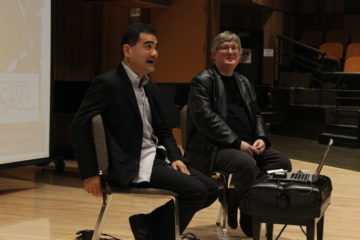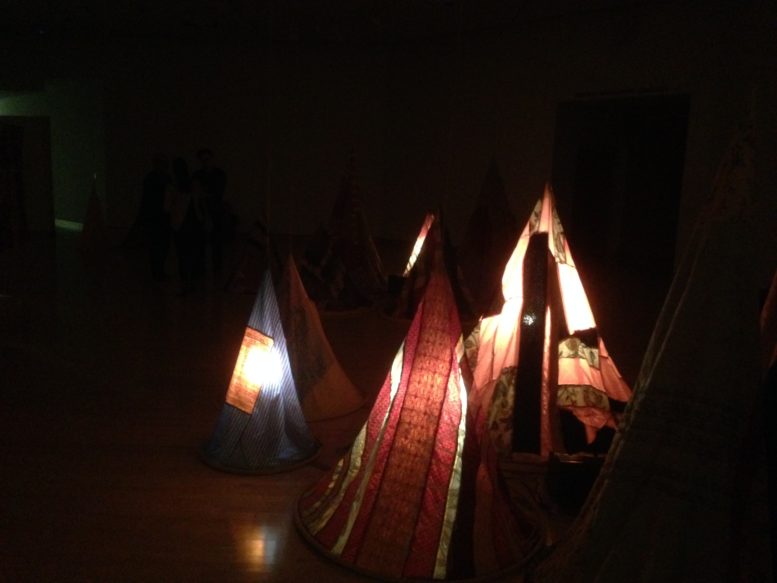By DAVID DUPONT
BG Independent News
The New Music Festival at Bowling Green State University is a fall ritual. Just before Halloween, BGSU becomes the center of the contemporary music universe.
Maybe that’s why this year’s event started on a macabre note – the opening of “The Deathworks of May Elizabeth Kramner.”
The art installation transforms the Bryan Gallery in the School of Art into a village of the dead. The conceit of the work by the Poyais Group is that folk artist Mary Elizabeth Kramner created these tents as a recreation of her German village, each structure representing how a former inhabitant died.
The viewer wanders about this village of the dead in darkness. The tents illuminate at odd intervals, and small organs set among the tents emit mournful chords. The viewer is suspended between life and death, between reality and fantasy. The mystery seeps into the bones.
Yet festival, hosted by the MidAmerican Center for Contemporary Music, celebrates the music of living composers. Presenting the expected is not in the festival’s mission statement.

Dai Fujikura (left) interviewed by Kurt Doles.
In another seasonal coincidence, this year’s featured composer is Dai Fujikura, who told the audience at the Composer Talk, that he was influenced early on by the musical scores of horror films.
He was about 10, and growing up in Osaka, Japan. This was the music he loved to listen to. He was also drawn to composition because he was a mischievous piano student. He said if he didn’t like a measure of music, even by Beethoven, he would change it. And why did Haydn have a measure of rest? He would just ignore it, much to the displeasure of his piano teacher. “She was right,” he concedes now.
The Composer Talk is a staple of the festival, its keynote address. But every featured guest composer presents it in a different way. Sometimes they delve deep into the intricacies of their scores; sometimes they wax philosophical; and sometimes, as was the case with Frederic Rzewski 10 years ago, they perform.
Fujikura’s talk was actually an interview with Kurt Doles, the executive director of the MidAmerican Center.
The composer told Doles, and the audience, that he didn’t like watching the horror films, but loved listening to the music. His favorite score is “Alien 3” by Elliot Goldenthal. He liked the way the music mixed in at one point with the sound effects of a human being eaten.
He speculated that he loved those scores because the composers stretched instruments to their limits and beyond, mined them for new sounds. Fujikura employs this ever-expanding language of extended techniques in his own music.
He explores those sounds in close collaboration with the artists who commission him to write music. He played a recording of a Skype conversation he had with flutist Claire Chase. In it they discuss the various ways in which her voice could be integrated with her playing. That technique she said had never been fully exploited, she said.
When musicians commission a piece by Fujikura, he tells them to expect daily contact. He once even asked a member of the ICE ensemble to play a bit of a score on Thanksgiving, admitting he really didn’t know how big a holiday it was for Americans.
When he’s commissioned by a “superstar” performer who is busy touring the world, Fujikura will work with a performer he knows who plays the same instrument. The super star gets to premier the piece, but then that collaborating artist is free to perform it because it really is their piece, the composer said.
Pieces by Fujikura were scheduled to be performed on seven of the eight concerts in the festival. On Thursday pianist Laura Melton performed “Frozen Heat” from 1998. This is the earliest of his pieces that he still allows to be performed, he told Dole. On Thursday night at a concert at the Clazel in downtown Bowling Green his pieces “Uto” for a quartet of percussionists and “Glacier” were on the bill. His penchant for extended techniques was on full display on “Glacier,” which was performed by Kenneth Cox on solo bass flute.
In another nod to the season, that show was closed out by performance artist Matt Marks doing part of his opera “Headphone Splitter” about an ax murderer on the loose among the hipsters of Brooklyn.
Earlier on Thursday, Andrew Pelletier performed Fujikura’s “Poyopoyo” for solo French horn. The composer talked about how he wanted to go against the “macho” spirit that so often is expressed in music for horn.
The piece was inspired in part by how fat and soft his daughter’s cheeks were. “Good enough to eat,” he said, laughing. His daughter has been a constant source of inspiration because, especially when she was a baby, she was constantly changing.
Tonight (Friday, Oct. 21) the festival’s guest ensemble the Spektral Quartet will perform his String Quartet No. 1 “Another Place” at a concert that starts at 8 in Kobacker Hall. Saturday night at 8 at the festival’s culminating concert the Bowling Green Philharmonia, directed by Emily Freeman Brown, and the Wind Symphony, directed by Kenneth Thompson, each will perform one of the featured composer’s works. The orchestra will play “Tocar Y Luchar” and the wind ensemble will play “My Butterflies.”
Music from close to home is also spotlighted at the festival.
The Spektral Quartet will perform BGSU faculty member Mikel Kuehn’s String Quartet No. 1 (if on a winter’s night…). Music by faculty members Christopher Dietz, “Winter Sunset,” and Marilyn Shrude, “Soto Voce,” was also programmed at the festival.
And at Saturday night’s concert, a representative of the new generation will be featured. The Philharmonia will give premier performance of Emily Custer’s “Seelenruhe.” Custer wrote the symphonic sketch while studying at BGSU with Dietz and Shrude. Custer received her Master’s of Music in composition from BGSU.
“Seelenruhe” won first prize last year in the College of Musical Arts’ annual Concerto Competition last year. A year ago, it was selected for the score reading session with the Toledo Symphony Orchestra.
Writing at the time I noted that the piece was inspired by a remote lake in her native Minnesota. Custer evokes not so much the lake itself as the feelings of the person venturing on its waters. “Seelenruhe” is aptly atmospheric, with plaintive melodies seasoned by harp and a soliloquy for the concertmaster.
It’s easy to imagine that lake surrounded by the brilliance of fall colors, just as at BGSU, listeners are surrounded by the vivid sounds of music of their time.

